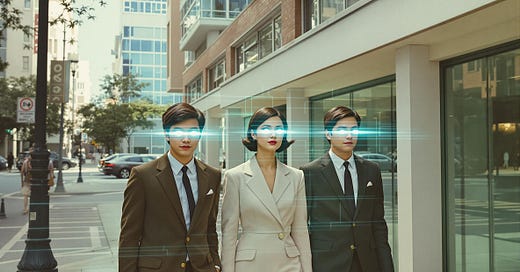When We Started to See The World Through Augmented Eyeballs
When implants replaced glasses, what we saw became negotiable.
By 2035, seeing wasn’t believing anymore.
Augmented reality (AR), once confined to clunky glasses and headsets, had moved inside us—literally. AR implants, surgically embedded in the eye, promised seamless integration between the physical and digital worlds. What began as convenience became a revolution, reshaping everything from daily life to the way people thought about truth itself.
The first AR eyeball implants appeared in the late 2020s. They were initially developed to address medical necessities like restoring vision for the blind or assisting those with degenerative eye conditions. Their success in these fields spurred broader applications, and soon, the technology expanded beyond healthcare (just as hearing aids became commonplace for everyone, not just those with hearing difficulties).
Need directions? A glowing path appeared in your field of vision.
Struggling with names at a networking event? Implants offered discreet reminders.
By 2030, customization was king - people paid premiums for personalized overlays, from augmented landscapes to mood-specific color filters. Checking in at a Marriott came with upsell charges for a deeply personalized room experience that could just be as easily on the moon, or deep under the oceans, given memories of “Total Recall” for those of you old enough to remember.
Reality had been reduced to an aesthetic choice.
As it was happening, I had hoped that inbuilt AR could lead to greater empathy. Back in 2017 in London, there was a terrible fire at the Grenfell Tower, killing a stunningly awful 72 people. I knew London, and I knew where the tower was, and I had seen the news stories (on TV, a long time before our holo screens now), BUT I remember the very deep and real feelings I had when I saw it in person 6 months later. What I was seeing hadn’t become any more real, but the feelings certainly had.
For me, seeing was something much deeper than believing.
So if seeing something in real life could increase our level of understanding & feeling, seeing with AR might have been able to do the same. The 2018 Alexander J. Farrell “Refugee” movie was one of the first AR ones I ever saw, along with “Henry” (read about my interview with the director). This movie was about a Syrian refugee and a family’s fight to be reunited, and the VR format did far more to connect me deeply to the subject matter than 1,000 hours of regular film could ever have.
For every early adopter though, skeptics warned of a new kind of negative dependence. Yes, you could use it for good, BUT as we now know, more people chose to use it to filter OUT the unpleasant sights; the graffiti, the litter, and even the homeless, just being eradicated from the life experience.
Empathy took a dive.
Critics weren’t shouting into a void either. Black Mirror’s "Arkangel”, released 26 years ago in 2017, foreshadowed this ethical murkiness. In the episode, a mother uses a chip implant to monitor and control her daughter’s perception, shielding her from distressing images. What begins as protection spirals into control, eroding trust between parent and child. It was fiction, but its warnings were actually prophetic. By the time AR implants hit the mainstream, debates over autonomy, privacy, and manipulation had moved from television to boardrooms and courtrooms.
Governments quickly recognized the potential of augmented vision. Nationalistic advertising entered a new dimension, with parties vying for space in people’s sightlines. Some countries experimented with mandatory AR overlays for public health campaigns, displaying calorie counts on fast food or alerting citizens to environmental hazards.
By the early 2030s, resistance movements had emerged. Communities formed around the idea of "natural vision," rejecting implants in favor of unmediated experiences. These weren’t Luddites railing against progress, they were artists, activists, and thinkers trying to hold on to their creative domain.
Their manifesto was simple: reality didn’t need fixing.
Women were already an active powerhouse by this point, having had to rally in the 2020s against the US government’s creation of a compulsory pregnancy tracking register. Not your body, not his choice was loud and clear, and for many, they were not going to accept any more embedded tech that could reveal what they considered private.
Religious groups weighed in. For centuries, faith had wrestled with how technology intersected with belief, but AR implants posed new questions.
Could augmented overlays—visualizing halos around saints or animating scripture—enhance spirituality, or did they distract from the sacred? Were they a default necessity to even get anyone to engage?
A surge in church attendance in 2025, tied partly to political upheavals, hinted at a broader yearning for unfiltered connection. By the 2030s, sermons about "seeing the world as God intended" were drawing crowds.
In relationships, couples argued over filter settings, with transparency becoming a new form of intimacy. Asking someone to turn off their filters felt as personal as a shared secret.
A phenomenon I didn’t expect was that when someone disconnected, they began to question whether they were seeing the world as it was or still being tricked into seeing the AR world, leading to the all-too-common scenes of self-blinding.
Whatever the outcome, augmented eyes have forced humanity to look inward, asking questions like what we gain by enhancing perception and what do we lose when we surrender reality to a filter.
And, of course, who gets to control what we see?
[Image credit: AI Brand Photographer at FOMO.ai. FOMO.ai gets brands more traffic.] Grenfell Tower photo: Natalie Oxford)




